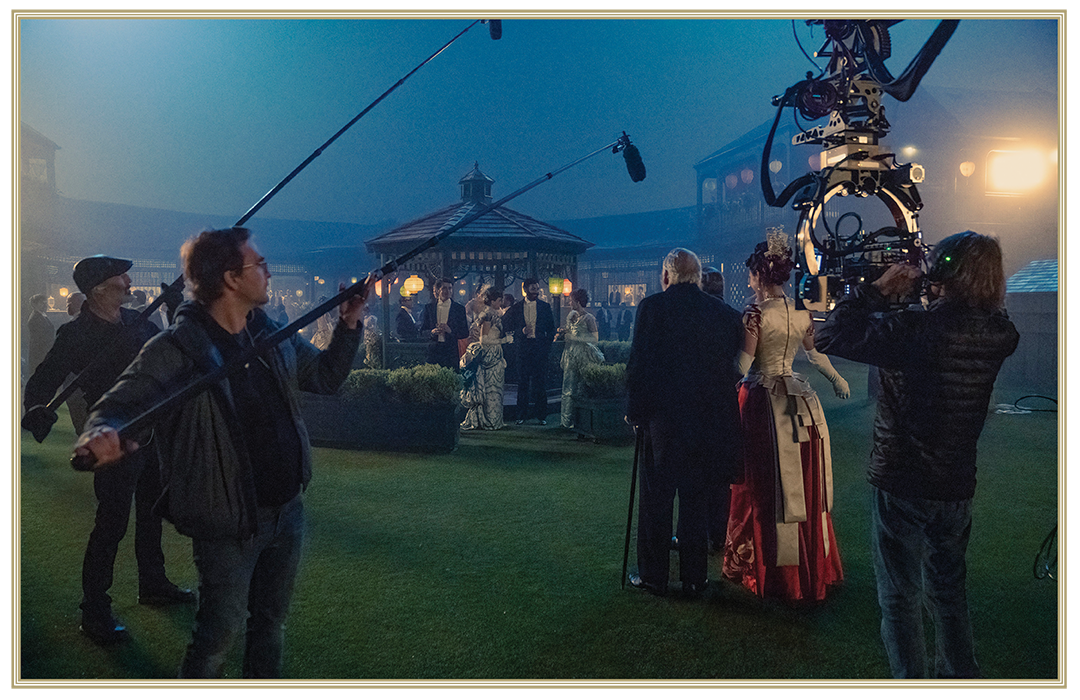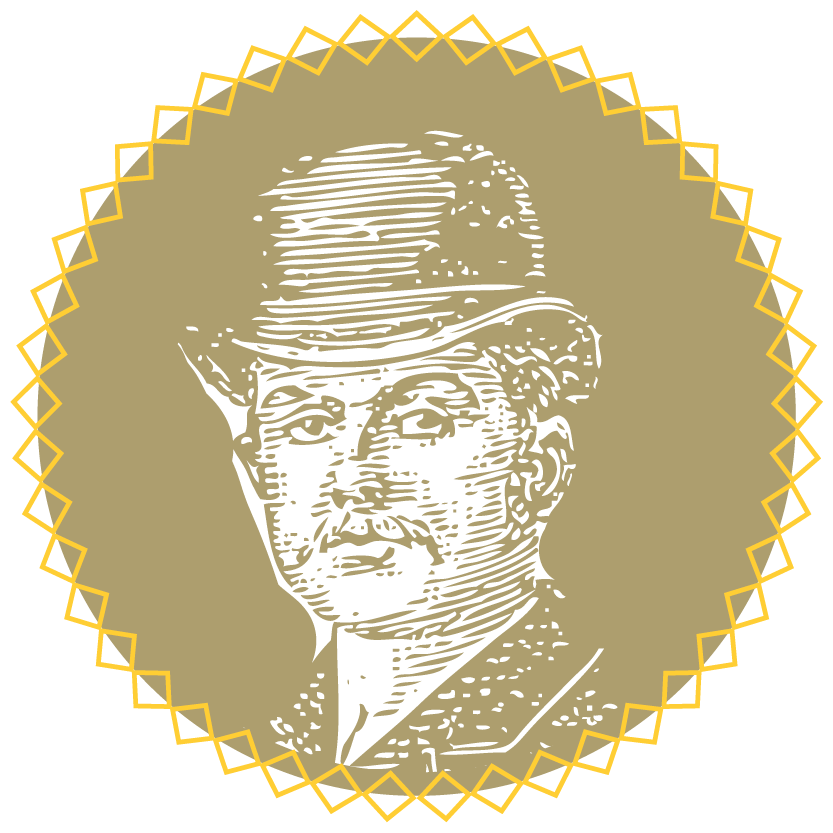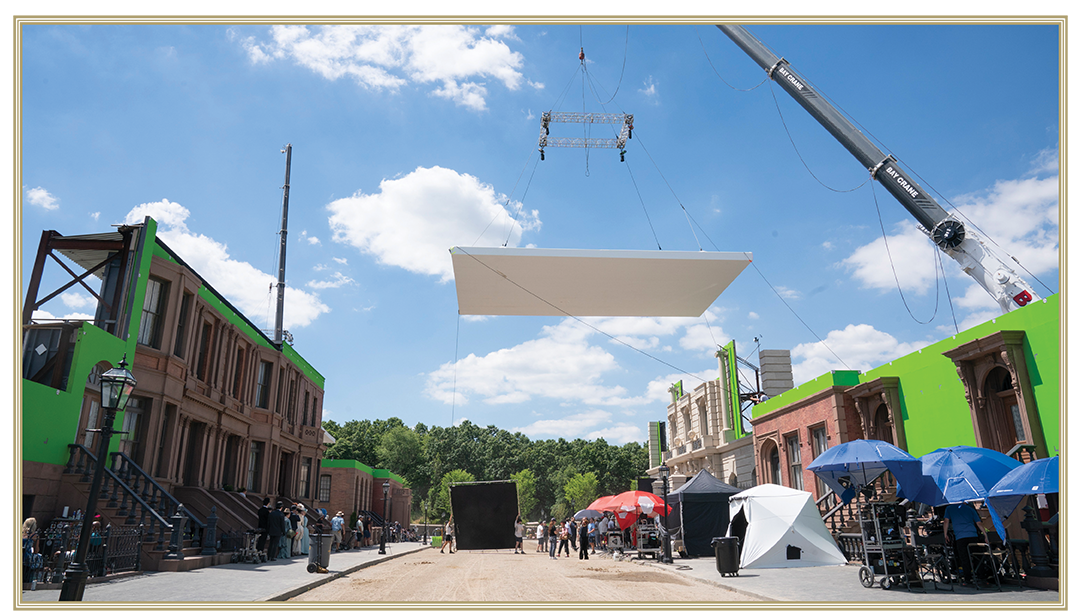Making the Magic Happen
Holly Rymon, B.A. '90, in The Gilded Age's wardrobe department in Brooklyn.
Whether wrangling 19th-century carriages for ‘The Gilded Age’ or managing Marvel superheroes, producer Holly Rymon, B.A. ’90, thrives where creativity meets chaos.
/ / by Lisa Conley-Kendzior
On the set of “The Gilded Age,” chaos hums just beneath the surface. Horses stamp their hooves as carriages creak into place. Extras in bustled gowns and starched collars adjust gloves and top hats under the glare of lights, while crews in jeans and headsets haul bolts of drapery into a stately mansion that, only hours earlier, was a museum gallery.
In the middle of it all, Holly Rymon, B.A. ’90, moves with practiced calm, checking in with department heads and scanning the schedule. To her crew, she is the steady hand guiding spectacle into order: a producer whose job is to make the magic onscreen look effortless, even when everything behind it is anything but.
“Producing is really about constant reprioritizing,” she says. “All day, every day, something shifts. You just have to get comfortable with change and making hard decisions quickly, then have confidence in those decisions and move on."

Behind the scenes of HBO's The Gilded Age.
“The Gilded Age”
Season 3
Fun Facts

2,354
pairs of shoes were used throughout the season.

1,957
hats were made or rented—including 203 custom creations, 100 of which were handcrafted in-house by the show’s two milliners.

375
costumes were custom made for Season 3, with 150 produced locally in New York City.
Pragmatism mixed with empathy has carried Rymon from rural Pennsylvania to New York’s soundstages and into the glittering ballrooms of Julian Fellowes’ Emmy-nominated HBO drama. Along the way, she has shaped Marvel’s superhero universe, overseen multimillion-dollar productions and navigated pandemic shutdowns, all while building a reputation as the kind of producer people want to work with again and again.
She hadn’t always pictured this life. As a teenager, Rymon imagined herself as an actor or a diplomat. “I knew I either wanted to save the world or entertain it,” she jokes. But growing up in the country, she had few opportunities for theater until a summer-stock company opened in a barn a mile from her home. She volunteered there as a middle schooler and was instantly hooked. “The life, the people, the magic of storytelling…it all got to me,” she says.
Still, a part of her thought she might “save the world,” leading her to GW’s renowned international-studies program in the heart of Washington, D.C. But she kept finding her way back to the theater department, volunteering on student shows between classes. Her father, a scientist and professor, was skeptical when she switched her major, but Rymon promised she’d take the craft seriously. “I had to tell him I was going to be professional about it,” she says. “It wasn’t a hobby; I wanted to make a real career out of it.”
Once she made that commitment, everything began to click. Immersed in GW’s theater program, she became fascinated by the technical side of storytelling. A lighting design course opened her eyes to the power of what happens behind the scenes—the artistry and precision that shape how a story feels. “I loved creating the visual beauty of lighting,” she says. “And I realized I was more of a practical problem solver than a performer.”
After graduation, she moved to New York, where jobs were scarce and the film and television industries still felt like separate entities. She worked as a camera assistant on low-budget projects while firing off résumés to anyone who would read them.
Her break came when she landed an internship in the production office of a Rob Reiner film. “I thought I’d hate the office atmosphere,” she admits. “But I realized I was good at organizing, and I started to respect the business side of filmmaking: the contracts, the insurance, all the machinery behind the art. That was a turning point.”
From there, she rose steadily through production management and line producing, absorbing lessons on every set, even the difficult ones. “Not every experience was going to be the best ever,” she says. “But even on the tough jobs, I learned what I didn’t want to do when I was in charge. Especially when it came to how people were treated.”
Those experiences shaped a leadership style rooted in respect and collaboration. Rymon makes a point of learning each crew member’s craft, believing that understanding the details of their work leads to better communication—and better films. “I don’t like asking people to do something I don’t understand,” she says. “If I know what it takes, I can make more informed decisions and show real appreciation for their expertise.”
Her approach helped her stand out in the early years, when she was often the only woman in rooms filled with stunt coordinators, camera operators and construction foremen. “I never apologized for doing my job,” she says. “I respected them, and they respected me—and yes, sometimes holding the budget didn’t hurt,” she adds with a wry shrug.
In 2016, Marvel Television came calling. Rymon started as production manager on “The Defenders,” the Netflix series uniting Daredevil, Jessica Jones, Luke Cage and Iron Fist. “At first I said no because I wasn’t sure it was for me,” she recalls. “But I thought, if I don’t try, I’ll always wonder. And it turned out I really enjoyed it.”
The role involved supervising multiple productions simultaneously—each with its own schedule, director and creative stakeholders. Navigating that web of competing needs sharpened her ability to manage complex situations. “It gave me an appreciation for what executives do,” she says. “And I understood my partners better because I’d been in their shoes.”

Behind the scenes of HBO’s The Gilded Age.
Rymon went on to produce episodes across the interconnected series, including “The Punisher,” a gritty fan favorite that explored the franchise’s darker side. But when Marvel Television folded back into Marvel Studios in 2019, she didn’t view it as a setback so much as the next evolution. “It was a good couple of years of learning,” she says. That adaptability prepared her for what came next: “The Gilded Age.”
HBO’s sumptuous drama transports viewers to 1880s New York, where old money and new fortunes collide in drawing rooms gilded with excess. Producing a period piece, Rymon quickly discovered, requires a different kind of foresight: costumes take six to eight weeks to design; locations are often historic homes or museums that must be emptied before filming and painstakingly redressed afterward; even drapery and wallpaper must be fabricated to period specifications. “You can’t just walk into a pizza shop and shoot,” she explains. “You’re creating a world from scratch.”
Her Brooklyn production office mirrors that meticulous mindset. Calendars line the walls, layered with color-coded Post-It notes, and clocks track time zones across the globe. In the quiet summer months before filming begins, only a few desks are occupied. But once production ramps up, the room transforms into a command center: phones ringing, printers spitting out revised call sheets, staff juggling scripts, budgets and schedules in real time.
One floor below the production office, the precision shifts from calendars to costumes. Racks of gowns and suits hang in neat plastic sheaths, while shelves brim with carefully labeled boxes: everything from “Cravats—Assorted Colors” to four bins devoted entirely to “Ladies Glove Buttons.” Walking those aisles feels like entering a historical archive, each item a thread in the tapestry of 1880s New York. “Walking through here, you realize how much is in the details,” Rymon says. “Every button, every glove, every fabric choice is part of telling the story.”
Her attention to detail also guided one of the show’s biggest undertakings: building a seven-acre backlot from the ground up. What began as an empty field became 19th-century New York streets, every lamppost, cornice and brick designed to endure both the scrutiny of the camera and the ravages of weather. “We built in massive steel and concrete to survive hurricane-force winds,” Rymon says. “We even installed our own power grid. Watching it rise out of nothing was incredible.”
Keeping such an operation on track requires more than logistics. For Rymon, it comes down to people. She makes a point of learning her crew’s names, families and lives outside work. “If I can create an environment where people feel respected and enjoy working with one another, that’s a success in itself,” she says.

Actors Carrie Coon and Morgan Spector on the set of HBO’s The Gilded Age.
Her emphasis on community proved vital during the pandemic, when production was scheduled to begin in March 2020 only to shut down three days before cameras rolled. Returning to set meant constant testing and rescheduling, as cast members fell ill at various times. “At one point, both of my cinematographers were out,” she recalls. “We were flying by the seat of our pants. But we made it through. Everyone pulled together.”
As the productions grew larger, the demands on her time multiplied, pulling her away from routines at home and nights with her family. Rymon credits her husband for taking the lead at home when their children were young. “That let me take the crazy hours, the overnight shoots, the overseas jobs. I couldn’t have done it without him,” she says with a smile.
When projects wrap, she carves out time to decompress—often by planning trips. “I love figuring out hotels and flights,” she says. “It helps me think forward to something relaxing.”
For all the pressures of the role, she measures success less by ratings and awards than by the atmosphere on set. “This business is made up of creative people who work incredibly hard,” she says. “If I can hire talented people who are also decent humans, and build a respectful, enjoyable environment, that’s huge.”
Still, awards nights bring their own kind of magic. In 2024, “The Gilded Age” picked up six Emmy nominations—including Outstanding Drama Series—and Rymon brought her daughter along for the ceremony. “It was super fun, and I felt like a little kid. One of my colleagues even spotted us on TV and said I looked so happy and comfortable,” she recalls. “I should’ve brought a snack in my bag, though,” she adds with a laugh.
Looking ahead, Rymon isn’t interested in repeating herself. “I love world-building, creating environments that don’t exist anymore or never did. But really, I just like doing different things,” she says. “Each project has new challenges, and that keeps me learning.
“I always loved this business,” she adds. “I never questioned my choice after I made it.” The road has had its bumps, but the rewards have outweighed the hardships. “This industry takes a certain type of person. You either love it or you don’t. I’ve always loved it. And I’ve enjoyed the ride.”
When the cameras stop rolling on “The Gilded Age,” the actresses unlace their corsets, the horses are led back to their stalls, and the 19th-century streets of the backlot fall silent. Rymon lingers just long enough to thank her crew before turning to the next schedule on her desk. She’s already thinking ahead: to the next set, the next story, the next challenge. For her, the magic is in making order out of chaos—and knowing it’ll all start again tomorrow.
Photography: Barbara Nitke/HBO and William Atkins


